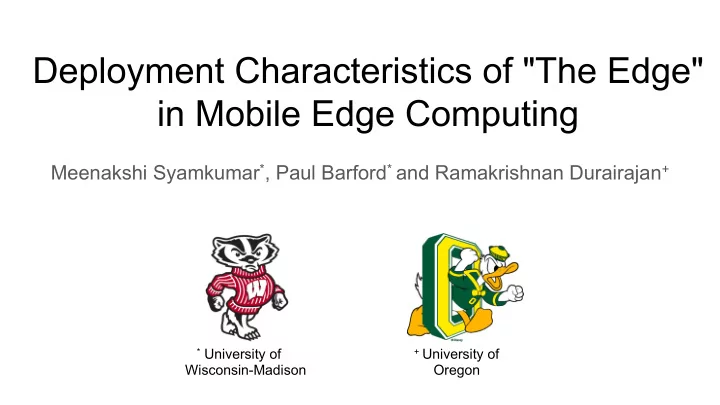

Deployment Characteristics of "The Edge" in Mobile Edge Computing Meenakshi Syamkumar * , Paul Barford * and Ramakrishnan Durairajan + * University of + University of Wisconsin-Madison Oregon
Where is “The Edge”? Edge Source: www.onlinewebfonts.com/icon Our definition: Locations of cellular towers – primary service infrastructure for mobile devices 2 ms@cs.wisc.edu
Computation at “The Edge” • Push computation closer to users • Reduce edge-to-core latencies for mobile devices • Deploying compute at each edge location is impractical! Research question: How to identify the best “Edge” locations for deploying “Mobile Edge Computing (MEC)” micro data centers? Cell tower proximity Cell tower proximity to population to compute Proximity Analysis MEC Deployment Analysis 3 ms@cs.wisc.edu
Datasets • OpenCelliD (https://opencellid.org/) • Crowd-sourced dataset of ~5 million cell tower geolocations in US • Filtering: • US boundary filtering • National Hydrography Dataset (NHD) filtering • Census (https://www.census.gov/) • Shapefiles: US outline, Metropolitan Statistical Area (MSA) boundaries and block-level population estimates • Tables of population estimates • Internet Atlas (http://internetatlas.org/) • Repository of Internet infrastructure dataset gathered from public sources via web search • Average Annual Daily Traffic (https://wisconsindot.gov/) • Count of vehicles per day using a section of highway 4 ms@cs.wisc.edu
US cell tower geo footprint ESRI ArcMap visualization of cell towers locations from OpenCelliD 5 ms@cs.wisc.edu
Metropolitan Statistical Areas (MSA) • Most populated geographical regions in the US • Top 3 MSAs MSA #Cell towers Population New York 310,916 20,153,634 Los Angeles 248,227 13,310,447 Chicago 174,348 9,512,999 6 ms@cs.wisc.edu
Top 10 MSAs 7 ms@cs.wisc.edu
US data center geo footprint ESRI ArcMap visualization of data centers from Internet Atlas 8 ms@cs.wisc.edu
Talk outline Cell tower proximity Cell tower proximity to population to compute Proximity Analysis MEC Deployment Analysis 9 ms@cs.wisc.edu
Proximity analysis 1. Compute coverage area of each cell tower using Voronoi tessellation [Candia et al. Journal of Physics 2008, Taylor et al. GLOBECOMa 2012] 2. Compute area of each Voronoi cell 3. Compute total area of Voronoi cells contained within a Census Block 4. Estimate population served per Voronoi cell by assigning proportioned value as per area covered 5. Categorize the cell towers into 5 classes based on served population Further details in the paper! 10 ms@cs.wisc.edu
Voronoi tessellation Cell towers (black), Voronoi cells (red) and Census Blocks (blue) in the Manhattan area of NYC 11 ms@cs.wisc.edu
Cell tower proximity classification – NY MSA 12 ms@cs.wisc.edu
Cell tower proximity classification – LA MSA 13 ms@cs.wisc.edu
Proximity analysis near highways • Utilizes Average Annual Daily Traffic (AADT) counters • Cell towers within quarter mile from highway • Assumptions • Drivers are evenly distributed • Drivers are active over a 20 hour period • 1 Driver / cell per vehicle • Calculate per-hour estimate of drivers served per Voronoi cell 1. Compute area of each Voronoi cell 2. Manually draw the highway section boundary 3. Compute total area within boundary 4. Assign proportioned value of per-hour estimates as per area covered 5. Categorize the cell towers into 5 classes based on drivers served 14 ms@cs.wisc.edu
Cell tower proximity classification - highway Per cell tower driver estimate variation for I-94 in Wisconsin 15 ms@cs.wisc.edu
Talk outline Cell tower proximity Cell tower proximity to population to compute Proximity Analysis MEC Deployment Analysis 16 ms@cs.wisc.edu
MEC deployment model Source: www.onlinewebfonts.com/icon Deploy MEC micro data centers at the “Edge” 17 ms@cs.wisc.edu
MEC deployment analysis Objective: Reduce latency – modelled as distance to closest compute • Base case • Existing data centers from Internet Atlas dataset • Latency: closest compute for each tower – geographically nearest data center • Tier-1 case • Deployment of MEC micro data centers co-located with cell towers in red class • Latency: closest compute for each tower – geographically nearest data center or deployed MEC micro data center • Tier-2 case: MEC deployment at cell towers in orange class • And so on up to Tier-4 18 ms@cs.wisc.edu
Distance reduction to compute Reduction in distance (latency) to closest data center or MEC micro data center 19 ms@cs.wisc.edu
Deployed MEC micro data centers Number of existing data centers and MEC micro data centers deployed at each deployment tier 20 ms@cs.wisc.edu
Per cell tower distance reduction (Tier-1) Distance reduction for Tier-1 deployment in top 10 MSAs 21 ms@cs.wisc.edu
Per cell tower distance reduction (Tier-2) Distance reduction for Tier-2 deployment in top 10 MSAs 22 ms@cs.wisc.edu
Conclusions and future directions • US consists of at least 5 million cellular towers • Deploying MEC micro data center at each location is impractical! • We propose a tiered MEC deployment which brings compute closer to population • Tier-1 deployment reduces distance by 12 miles for greater than 10% of cell towers • Ability to incorporate dynamic counters like AADT • Future work • Extend proximity analysis to include dynamism • Incorporate Call Detail Record (CDR) datasets • Extend deployment analysis to include metrics: • Individual server capacity • Links capacity 23 ms@cs.wisc.edu
24 ms@cs.wisc.edu
Recommend
More recommend